Bill Signs: Following in Lindbergh's Footsteps
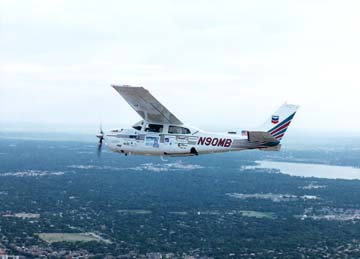 As Bill Signs explains it, he's an expeditioner, not an adventurer. I think as you read his interview you'll agree with me that his aviation exploits go far beyond normal cross country flights. I had the opportunity to sit with Bill as he prepared for his commemorative flight honoring Charles Lindbergh's great achievement that took flight 70 years ago.
As Bill Signs explains it, he's an expeditioner, not an adventurer. I think as you read his interview you'll agree with me that his aviation exploits go far beyond normal cross country flights. I had the opportunity to sit with Bill as he prepared for his commemorative flight honoring Charles Lindbergh's great achievement that took flight 70 years ago.
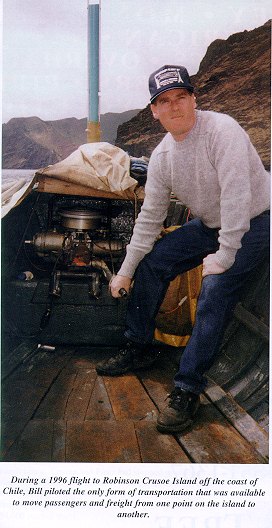
Texas Flyer: Bill, you've got a passion for long distance flight. Why?
Bill Signs: I guess it's a test for me personally and also a test for the
airplanes that I put together. It's a continuing test of my skill
levels and maintenance expertise to keep the airplane flying in good
condition.
Texas Flyer: It seems that the more I get to know you, there's something
ticking inside you that's not ticking inside a lot of other
pilots. Have you ever been able to put your finger on it?
Bill Signs:
I don't think so. I just want to go out and see things, I guess.
I don't want to do it in a sailboat. It's too slow.
Texas Flyer:
Is this a form of therapy for you? Where other people go out and
jump in a sailboat, and other people go climb a mountain -- you fly
long distance flights?
Bill Signs:
That could be. Maybe it's something that I have to have that
says that I'm in control. I recall being on the ground in Egypt
having all these Egyptian soldiers around the airplane and giving
me a hard time. Once the wheels were off the runway and the gear
was up -- at that point I was at ease. At that point I was in
control.
Texas Flyer:
You've made about a half a dozen friendship flights in the past
few years. Has there been one thing that stood out as far as the
most exciting thing, most unique, most dangerous?
Bill Signs:
I'd say there are probably four areas that I've visited that I'd
classify as the most interesting. The first would be St. Petersburg
in Russia and being able to travel all over Russia. The next would
be Manaus, Brazil, which is on the Amazon River Basin. Third would
probably be the Falkland Islands and after that the Pribilofg Islands
off the coast of Alaska in the Bering Sea.
Texas Flyer:
Take us through each one of those location and tell us what made
it stand out?
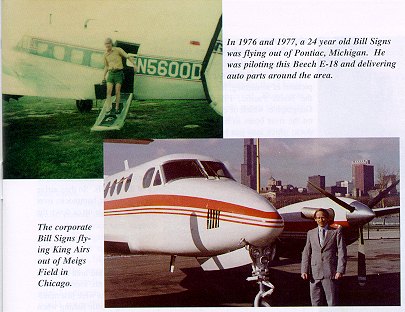 Bill Signs:
Russia is interesting. Ever since I was born, the Cold War
between the USSR and the USA has basically been going on. For all
those years our government has told us how horrible and evil the
Russian people were. But going over there and seeing the neat
museums that they have and just really how nice the people were and,
I guess, the sense of adventure that I had in going into the
enemy's back yard - I learned that people are people. I think
there was some mystique to it, some adventure and probably an
ill-conceived threat that our government has worked so hard for all
of us to think how dangerous those people are. But no matter where
you go in this world people are just looking for a safe place to
raise their kids. That's it. No more, no less.
Bill Signs:
Russia is interesting. Ever since I was born, the Cold War
between the USSR and the USA has basically been going on. For all
those years our government has told us how horrible and evil the
Russian people were. But going over there and seeing the neat
museums that they have and just really how nice the people were and,
I guess, the sense of adventure that I had in going into the
enemy's back yard - I learned that people are people. I think
there was some mystique to it, some adventure and probably an
ill-conceived threat that our government has worked so hard for all
of us to think how dangerous those people are. But no matter where
you go in this world people are just looking for a safe place to
raise their kids. That's it. No more, no less.
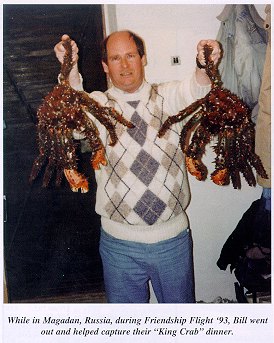 Texas Flyer:
It doesn't matter if you are in the U.S. or South America or
Russia, or wherever...
Texas Flyer:
It doesn't matter if you are in the U.S. or South America or
Russia, or wherever...
Bill Signs:
Mongolia -- is doesn't matter. The number one objective -- to
raise your kids, and/or your grandkids in a safe, peaceful
environment.
Texas Flyer:
Was it an eye-opening experience for you?
Bill Signs:
I think so. The people in Russia are just so generous. I'd
just give them a simple business card with a picture of my airplane
on it and they were pulling off personal items like watches, and
sunglasses, to give you something back. They have so little and
yet they are very generous. Whatever they have, they are going to
share it with you. I also found that in the South Pacific cultures
and the Native Eskimo cultures up in Alaska -- you just share
everything.
Texas Flyer:
Second location was the Amazon Valley?
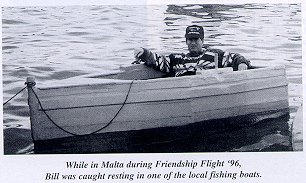 Bill Signs:
Manaus, Brazil, is right smack in the center of the Amazon River
Basin. There are about a million people who live there, right on
the joining of the waters of the Negro and Amazon river. What's
really interesting is that onve you get about ten miles out of town
the paved road turns into a dirt road that turns into a dirt lane,
and that's it. Because most of the people there are poor, they
travel by river boat. It's what our river boats on the Mississippi
would have been like 100 years ago during Mark Twain's time. It's
just so remote. If you fly out, say 50 or 70 miles to some
neighboring air strips, you'll see people walking out of the jungle
with shorts on and a spear and nothing else.
Bill Signs:
Manaus, Brazil, is right smack in the center of the Amazon River
Basin. There are about a million people who live there, right on
the joining of the waters of the Negro and Amazon river. What's
really interesting is that onve you get about ten miles out of town
the paved road turns into a dirt road that turns into a dirt lane,
and that's it. Because most of the people there are poor, they
travel by river boat. It's what our river boats on the Mississippi
would have been like 100 years ago during Mark Twain's time. It's
just so remote. If you fly out, say 50 or 70 miles to some
neighboring air strips, you'll see people walking out of the jungle
with shorts on and a spear and nothing else.
Texas Flyer:
In other words, you saw National Geographic first hand.
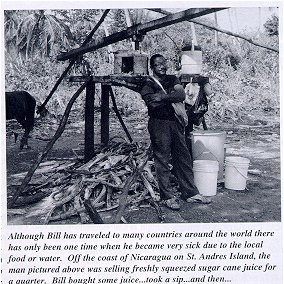 Bill Signs:
I guess this is what I find unique in my travels. When I take
some pictures of something, like I did recently in Tarwa in the
Gilbert islands in the South Pacific, I'll find a very similar
picture in the National Geographic, which of course we all look up
to. I find the folks traveling on the river boats to be real
interesting. They normally get to the boad dock, which may just be
a spot on the beach, about two hours before the boat will leave.
They bring their hammocks and food because there are no rooms and
no restaurant on board. Since there's no refrigeration on
the boats and if they want to eat fresh meat, they bring it along
with them. And that includes live chickens in cages. They usually
have a community slaughtering and cooking area on the back of the
vessels. So they arrive at the boat docks with their cages of
chickens and their hammocks over their shoulders ready for the four
or five or six day voyage up or down the Amazon.
Bill Signs:
I guess this is what I find unique in my travels. When I take
some pictures of something, like I did recently in Tarwa in the
Gilbert islands in the South Pacific, I'll find a very similar
picture in the National Geographic, which of course we all look up
to. I find the folks traveling on the river boats to be real
interesting. They normally get to the boad dock, which may just be
a spot on the beach, about two hours before the boat will leave.
They bring their hammocks and food because there are no rooms and
no restaurant on board. Since there's no refrigeration on
the boats and if they want to eat fresh meat, they bring it along
with them. And that includes live chickens in cages. They usually
have a community slaughtering and cooking area on the back of the
vessels. So they arrive at the boat docks with their cages of
chickens and their hammocks over their shoulders ready for the four
or five or six day voyage up or down the Amazon.
Texas Flyer:
Okay, third. The Falkland Islands.
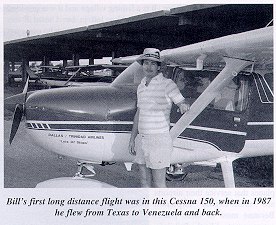 Bill Signs:
There are about 2,000 people that live on the island area that
runs about 150 miles east and west, 100 miles north and south,
located about 400 nautical miles off the coast of Argentina. These
folks were just minding their own business, raising their sheep and
doing a little fishing when they were invaded by Argentina in 1982.
Twelve hundred people live in the town of Stanley, which is on the
eastern area of the Falkland Islands and the other 800 folks are
sprinkled over the vastness of these islands out in the South
Atlantic.
Bill Signs:
There are about 2,000 people that live on the island area that
runs about 150 miles east and west, 100 miles north and south,
located about 400 nautical miles off the coast of Argentina. These
folks were just minding their own business, raising their sheep and
doing a little fishing when they were invaded by Argentina in 1982.
Twelve hundred people live in the town of Stanley, which is on the
eastern area of the Falkland Islands and the other 800 folks are
sprinkled over the vastness of these islands out in the South
Atlantic.
It was interesting to see their old ships. One in particular, a
three-masted sailing vessel that was built in the 1860's, was
there stuck in the mud - just abandoned there. Side paddlehwheelers
are sitting there, docked up, that were abandoned years ago. The
Falkland Islands are right smack in the middle of what they call
the "furious fifties," one of the most horrific areas for weather
in the world. These vessels would get damaged going around Cape
Horn of attempting to pass around Cape Horn. They would just kind of
chug back to the Falkland's if they were damaged and
couldn't make it wherever they were going to go, and end up
abandoning the vessel there. It's interesting that the Falkland
Islands did originally belong to Argentina as a posession and it
seems that approximately 150 years ago, a British sailing vessel was
damaged attempting to go around Cape Horn and the vessel made it
back to the Stanley area. The captain said, "Well, I know we were
trying to get to New Zealand and this kind of looks like New
Zealand here, so why don't we just stay here?" At that time, there
were not many inhabitants on the Falkland Islands so that started
an influx of British people. They basically squattedon the area.
Initially the Argentine folks were hospitable and let them stay
there, but more and more people came. Then the British decided to
use their gun boat diplomacy to take the Falkland Islands away from
the Argentines. So I can understand a little bit why the Argentine
people were miffed at the Brits. If they'd just gone in an killed
the first Brits 150 years ago instead of being hospitable, they
would still have the islands today.
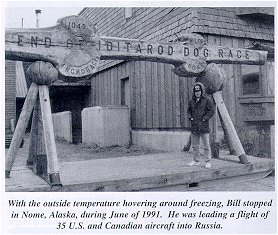 For five miles around Stanley, 80 percent of the area still has
active land mines. The land mines are virtually made out of all
plastic. The only piece of metal in there is in the detonator
about the size of a ball in an ball point pen, just miniscule,
probably fifteen thousandths of an inch across, so when they try to
find them... they cant.
For five miles around Stanley, 80 percent of the area still has
active land mines. The land mines are virtually made out of all
plastic. The only piece of metal in there is in the detonator
about the size of a ball in an ball point pen, just miniscule,
probably fifteen thousandths of an inch across, so when they try to
find them... they cant.
Texas Flyer:
Your fourth area was another set of islands.
Bill Signs:
Those were the Pribilof Islands about 300 miles north of Dutch
Harbor in the Aleutian Island chain and about 300 miles off the
west coast of Alaska. The people who live thgere are Aleuts,
native Americans. Not Eskimo people -- the Eskimo people live on
land and the Aleuts live more on water areas. But it is a little
town of about 300 people just in the middle of nowhere. It is a
fishing villiage and it was just kind of neat to see -- it was
an active culture left in our United States because it was so
isolated from anything. The only folks who come out are bird
watchers -- virtually all of the women tourists there look
like Ms. Jane out there from the Bevery Hillbillies, looking for
those birds. It was just so unique to see people who were so
preserved. There were probably, out of the undreds that I saw,
maybe only one or two white people. It was very unique to see a
culture still intact.
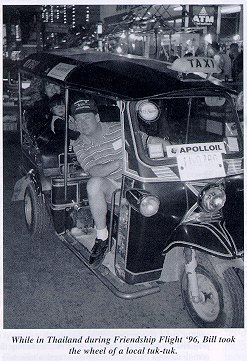 Texas Flyer:
What kind of response do you get when you drop into these
isolated cultures in a modern Cessna 210?
Texas Flyer:
What kind of response do you get when you drop into these
isolated cultures in a modern Cessna 210?
Bill Signs:
Well, a lot of the areas are so remote that the only airplanes
that service their airports are multi-engine airplanes. Because
most of these places are so remote, like the Pribilofs, or like the
interior of Russia, you are treates a little bit like a
mini-Lindbergh. The mayor would normally come out and they would
take you out to dinner and show you around town and show you the
special sites of the area. Maybe that is one reason I like going to
these areas -- I get treated well.
Texas Flyer:
Have you had some strange food served to you in some of these
locations?
Bill Signs:
During my last trip six months ago up to Churchill, Manitoba, I
shared a caribou leg with an Eskimo family. We just passed it around
the table and cut chunks off it.
Texas Flyer:
Cooked or raw?
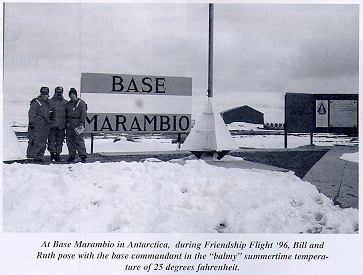 Bill Signs:
Semi-cooked. In Thailand, there were some special bugs that
they served which I passsed on and in a little area in Thailand you
could pick out your fresh frogs and eels from the case and they
would cook them right there for you. But I passed on those, too.
Probably one of the most interesting dinners I had was in Luxor,
Egypt. I met a local shop keeper there and he invited me to his
house. After talking to him for a while, he offered to let me
marry his niece and take her back to the United States for $1,200.
I though she was about 20 years old but it ended up she was 15.
During dinner, the man (who was about 41) would not allow his wife
(who was about 20) to ocme out of the kitchen. He threw a piece of
pita bread, like a frisbee, into the kitcken and it landed on the
floow and she was expected to eat off it... and she did. She fed
herself and the kids right off the floor with the pita bread. I
didn't know exactly what everything was there but I ate it and
smiled.
Bill Signs:
Semi-cooked. In Thailand, there were some special bugs that
they served which I passsed on and in a little area in Thailand you
could pick out your fresh frogs and eels from the case and they
would cook them right there for you. But I passed on those, too.
Probably one of the most interesting dinners I had was in Luxor,
Egypt. I met a local shop keeper there and he invited me to his
house. After talking to him for a while, he offered to let me
marry his niece and take her back to the United States for $1,200.
I though she was about 20 years old but it ended up she was 15.
During dinner, the man (who was about 41) would not allow his wife
(who was about 20) to ocme out of the kitchen. He threw a piece of
pita bread, like a frisbee, into the kitcken and it landed on the
floow and she was expected to eat off it... and she did. She fed
herself and the kids right off the floor with the pita bread. I
didn't know exactly what everything was there but I ate it and
smiled.
Texas Flyer:
Did the food or water ever upset your system?
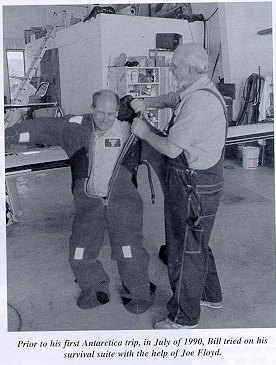 Bill Signs:
Normally I'm very careful about the water. I carry a little
Clorox with me and put a little drop in any water I'd suspicious
of. I know a lot of people get upset about having chlorine in
their water but ewhen I'm on the road and I run into water that's
chlorinated, I just guzzle it down. Chlorinated water is the best
drink on the road since I know that I'm not going to get sick. My
worst case of dysentery would have been on San Andreas, off the
coast of Nicaraqua. (It is a Colombia posession.)
Bill Signs:
Normally I'm very careful about the water. I carry a little
Clorox with me and put a little drop in any water I'd suspicious
of. I know a lot of people get upset about having chlorine in
their water but ewhen I'm on the road and I run into water that's
chlorinated, I just guzzle it down. Chlorinated water is the best
drink on the road since I know that I'm not going to get sick. My
worst case of dysentery would have been on San Andreas, off the
coast of Nicaraqua. (It is a Colombia posession.)
I met a man who was living under a four by eight piece of tin. He
lost his job in the hotel, so his brother let him borrow a horse
and the cugar cane press to make money pressing sugar cane. The
horse's job was to be attanced to the press and to keep walking
around in circles while he fed pieces of sugar cane into the press
and squeezed it for juice. He had a coleman cooler there and some
little cups. I bought a cup of this juice for 25 cents. We were
standing by his press jabbering since he was one of the few people
there on the island who spoke English andmy Spanish was pretty
poor. I took one little sip of it and it was like drinking sugar
water mixed with housing insulation. Just like the pink stuff in
your attice -- and there were wads of it in the juice. When he
turned his head, I threw it oon the ground and went "..mm, boy,
this was good." I was there for three days, with the worst case
of dysentery I've ever had... It was horrible. I couldn't leave
the hotel room for more than about 15 or 20 minutes at a time.
Texas Flyer:
In 1996 you, along with Ruth Jacobs, flew an around-the-world
expedition called Friendship Flight '96 where you touched down in
all seven continents. Was there a time during that flight when
you thought, "Why am I here?"
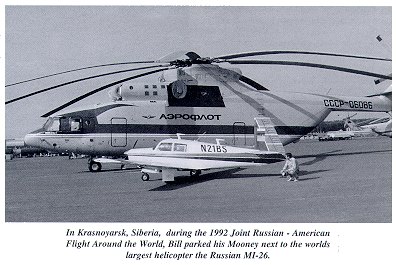 Bill Signs:
I think the most concern I had for an extended period of time was
after launching out of Honolulu for the non-stop flight to Van
Nuys, California. We picked up a tremendous 70 knot tail wind at
altitude, what's called the "pineapple express." We took off at
10 o'clock at night from Honolulu so that our arrival would be at
2 o'clock in the afternoon for a media event in Van Nuys. I don't
like flying at night over strange areas in a single engine airplane.
I prefer to fly over the water during the day and over ground at
night. During this extended night flight I imagined that the sea,
due to the winds, was very rough and I was really concerned that if
we had to ditch down there we wouldn't survive. The sun finally
came up and I could see the ocean 13,000 feet below us, hundreds of
square miles of the sea having from swells that we 50 to 60 feet
high with 10 foot white caps on top of those swells. It was like the
ocean was in super slow motion with everything moving up and down
and around.
Bill Signs:
I think the most concern I had for an extended period of time was
after launching out of Honolulu for the non-stop flight to Van
Nuys, California. We picked up a tremendous 70 knot tail wind at
altitude, what's called the "pineapple express." We took off at
10 o'clock at night from Honolulu so that our arrival would be at
2 o'clock in the afternoon for a media event in Van Nuys. I don't
like flying at night over strange areas in a single engine airplane.
I prefer to fly over the water during the day and over ground at
night. During this extended night flight I imagined that the sea,
due to the winds, was very rough and I was really concerned that if
we had to ditch down there we wouldn't survive. The sun finally
came up and I could see the ocean 13,000 feet below us, hundreds of
square miles of the sea having from swells that we 50 to 60 feet
high with 10 foot white caps on top of those swells. It was like the
ocean was in super slow motion with everything moving up and down
and around.
Texas Flyer:
When did you start flying?
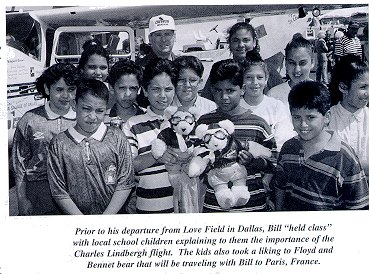 Bill Signs:
I started flying in 1969. I lived in a small farming community
in Ohio until I was 11 and was pretty much isolated from aviation.
However, we lived under an airway departing out of Cleveland. I'd
see the old Convairs and DC-6s; and as I got a little bit older,
there would be jets going over, climbing out and heading west. When
I was 11, we moved to Orlando and I learned that Florida has a very
active aviation community. Then one day I figured out that I didn't
have to hang on the outside of the fence around the airport but that
I could go in there and look at the airplanes and talk to the people.
At that time I was working in a boat yard, and during my junior
year of high school I enrolled in an adult education program for
aircraft mechanics and that's when I got my first general aviation
airplane ride. I went up with a guy in a Piper Tri-Pacer and we
flew aaround practicing stalls at about 1,000 feet. I didn't know
any better and I though, "Boy, this is fun." He had his wife and
kids in the airplane along with me and he was flying around
practicing his stalls at 1,000 feet AGL. That was my first flight.
Bill Signs:
I started flying in 1969. I lived in a small farming community
in Ohio until I was 11 and was pretty much isolated from aviation.
However, we lived under an airway departing out of Cleveland. I'd
see the old Convairs and DC-6s; and as I got a little bit older,
there would be jets going over, climbing out and heading west. When
I was 11, we moved to Orlando and I learned that Florida has a very
active aviation community. Then one day I figured out that I didn't
have to hang on the outside of the fence around the airport but that
I could go in there and look at the airplanes and talk to the people.
At that time I was working in a boat yard, and during my junior
year of high school I enrolled in an adult education program for
aircraft mechanics and that's when I got my first general aviation
airplane ride. I went up with a guy in a Piper Tri-Pacer and we
flew aaround practicing stalls at about 1,000 feet. I didn't know
any better and I though, "Boy, this is fun." He had his wife and
kids in the airplane along with me and he was flying around
practicing his stalls at 1,000 feet AGL. That was my first flight.
Texas Flyer:
Did you complete the aircraft mechanics course?
Bill Signs:
I got my power plant license when I was 18, and I was 22 or 23
before I went back for some more schooling to get the airframe
license. But I had my private license at 17, my commercial license
at 18 and ended up flying processed and unprocessed film at age 18.
When I was 21 I was running a flight school in Massachusetts with
10 airplanes. It's been a wonderful opportunity for me to live all
over the country.
Texas Flyer:
When was your first long distance flight that was more than just
a typical cross country?
Bill Signs:
The first long distance flight was in 1987. I was in a Cessna
150 and I flew it to Venezuela, South America and back. It had
standard fuel tanks so I had about four hours of fuel, enough for
about 300 miles with one hour of reserve. I met a lot of people
along the way and island hopped through the Caribbean. I had a
single nav-com, with no loran, no ADF, and of course no GPS at that
time. Once I got past St. Thomas, there were no more VORs so I
just grabbed headings for island to island. I was gone for about
six weeks, just hopping and skipping around the Caribbean.
Texas Flyer:
What brought that on?
Bill Signs:
I had always wanted to go there, down through the windward and
leeward islands, and it was time for a vacation. So I decided to go
and see what was there in a 150. I'd have to say that that trip was
the toughest trip I have ever flown in my life.
Texas Flyer:
Because I had no range beyond the normal fuel load and my radio
equipment was minimal for flying over water and over the hostile
jungle terrain of South America. Landing at St. Lucia I learned
that there were no tie-downs available. So I took my
screw-in-the-ground tie downs but with the volcanic soil on St.
Lucia I couldn't get the screw in the ground, it would just fall
right out so I pointed the nose of the 150 into the wind. That
night there was a tropical depression going through with blowing
reain and wind and with no tie downs all I could do was try to
find a ditch and put the nose of the 150 down into the ditch to
break the lift on the wing. I went to the hotel and with the wind
and rain beating against the window all night I laid there just
trying to figure out how to get the engine and the good pieces of
the airplane back the the United States. I figured I'd go out in
the morning and find a shipping pallet, get a hacksaw, and cut the
good airplane pieces off to ship home. I went out to the airport
the next morning and was amazingly surprised -- there she was,
still sitting there waiting for me. She didn't blow away.
Texas Flyer:
Looking back at that flight, were you as prepared as you should
have been?
Bill Signs:
I was prepared in that I had brought a locator beacon and a life
raft, but the trip did open my eyes to the fact that I needed a
bigger airplane. As soon as I got back home I started looking for
one. I ended up getting a Mooney, and with the auxiliary fuel
tanks that I installed it increased by range from my 300 nautical
miles with an hour's reserve to about a 1,200 nautical mile range
with an hour reserve.
Texas Flyer:
When did the concept of Friendship Flights begin?
Bill Signs:
Unofficially in 1990. That was the first flight I made across
the North Atlantic and into the European countries. When I
travelled to Europe (and even with the 150 flight to South America),
I wanted to make sure that I didn't portray an image of the "Ugly
American." I wanted to make sure that wherever I went I would have
something, a momento of the flight, to give to people that I met.
So I had cards and pictures printed up that I could give out wherever
I went. As Americans, we travel to so many countries now and the
only thing we do is take from them and demand prompt service. We
have a tendency to travel to countries with a superiority
attitude chip on our shoulders. When I go through customs or
immigration, I'm the dumbest guy you've ever seen. I just don't
know anything, and "Can you help me?" becomes my most used phrase.
Many of the government officials I deal with just shake their
heads about how ignorant I am because I don't portray an image of
superiority in any way. I always answer and repond, "Yes sir,"
"No sir," "Si senor," "No senor," and just be very polite. And I
don't have any trouble.
Texas Flyer:
Have you seen examples where other Americans have had problems
because of their attitude?
Bill Signs:
Oh, absolutely. There was a gentleman who flew across Russia,
I believe in 1991, and he ended up in a Russian jail. All of his
Russian support crew quit and bailed out on him. He was a video
available and part of the video is him sitting in the Russian jail.
In Magadan, Russia, he was forced to sleep in a shipping container
because he was told there were no hotels in town. He was staying
in that shipping container and at night at that lattitude in the
summer the temperature still gets down to 35 degrees or so. When
I landed at that same area I stayed in the ex-communist party's
executive suites in the hotel in downtown Magadan.
Texas Flyer:
What do you attribute the difference to?
Bill Signs:
I didn't arrive there with the American superiority attitude
chip on my shoulder. I wnet over there to learn about them and
their country and I behaved as a very thankful guest. The key to
going through other countries is to act like a guest and adjust
your flying to whatever their needs are. I see pilots trying to
fly VFR over Russia instead of IFR. The Russians can accept you
flying VFR, but it creates a work load of four or five times as
much for their system and they don't like that. So you need to
go with the flow. What I try to do is basically copy airline
operations. Fly IFR, stay high, and no scud running. As an
example, on my first trip to Alaska I called every place I was
going to land at and talked to pilots about flying in their area.
For every person I talk to I would ask them, "Now tell me one thing
not to do in Alaska that would get me in trouble." And virtually
every time their answer was: "Don't circle around the mountain tops
looking at the goats. We loose more tourists up here looking at
those damn goats." So I followed their advice and did not get into
trouble. Most places in the world can accept IFR a lot easier than
VFR. So I copied an airline type operation and didn't circle around
the mountain tops looking at the goats.
Texas Flyer:
When you leave on your trips do you have to put on a different
mindset?
Bill Signs:
Oh, definitely. And you're going to spend a lot of money in
areas such as landing fees. One day Brent Lemon and I were
departing Guayquil, Equador, heading out to the Galapagos Islands
and then returning. There were three landings involved and airways
fees, and the government collected $659.00. Our total flight time
for that trip was about ten hours in the air so our fees alone were
over $60 an hour paid to the government of Equador. I had one
gentleman who was a multi-millionaire travel with me on a trip; and
in Caracas, Venezuela they hit us for about $180.00. The fuel was
cheap, about 80 cents a gallon, but by the time we paid the landing
fees and the handling fees and everything else our bill came to
$180.00. We paid the bill and were crawing into the airplane
getting ready to leave when a soldier came up and said, "I need
$10.00." He said, "You can't take off until you pay me $10.00."
So the gentleman I was with, who could easily afford to pay the
$10.00, hadn't had his nap that day and got kind of rude with this
young soldier with an automatic weapon and told him, "I am going to
leave. I am not going to pay any more here at this place." So the
soldier said, "Well, if you start to leave I am going to shoot the
airplane." And my friend stands back and says, "Go ahead. Shoot
that airplane." So I ran up there with the $10.00 and said, "No,
no, no, no, no, no. Don't shoot the airplane. Gracias senor." So
be prepared. Things are much different outside of our borders.
It's going to cost you an arm and a leg to travel around other
countries. Fuel on the Antarctic Peninsula will generally cost
$25.00 a gallon. If you can negotiate a good deal, you might be
able to get it for $12.50 a gallon. It's very expensive to fly in
other countries so the number one rule is to "be prepared." Every
time Ruth and I were on short final about to land in a foreign
place, I'd call out "attitude check!" That wasn't for the attitude
of the airplane or the landing gear or even the configuration of the
airplane, but for our personal attitude. What we did is make a
little game out of it. We both put on a big, toothy smile,
and for just a few seconds smile at each other so we'd remember to
be prepared for what was about to meet us... including the
challenges of getting through customs, immigration, agriculture,
bug spraying, commandants at the airport, flight plans, whatever.
Normal turnaround in a foreign country to park, put on a load of
fuel, and leave will take about three hours. That's three hours
just to get a load of fuel.
Texas Flyer:
Friendship Flight '97 is a little bit different than your
previous flights. Tell us about Friendship Flight '97.
Bill Signs:
Operationally, Friendship Flight '97 will be simpler than the
seven continent expedition. When I started thinking about
commemorate rating Lindbergh's flight I believe I was somewhere over
the South Pacific flying one of those 15 hour legs coming back from
Australia and I though, "What am I going to do when I get home? What
am I going to do for '97?" Then I realized that 1998 is the 70th
anniversary of Lindbergh's flight and thought that it would be a
neat idea to commemorate his flight. The Experimental Aircraft
Association has the Young Eagle program to get kids out to the
Airport and I wanted to create an environment where more kids could
come out to the airport -- rich kids, middle income kids, poor
kids -- and have the opportunity to be a part of recreating a
historical event and also get to sit in and touch a variety of
aircraft from antiques to airliners. I wanted the kids to be
able to actually crawl inside and see how they are built and held
together. I initially though, "Well we might be able to get maybe
a thousand kids out to the airports, wouldn't that be nice?" Well,
Friendship Flight '97 has natured. I learned recently that two
days after my arrival at LeBorget Airport in Paris, there will be a
national model flying contest at LeBorget with more than 2,000 kids
taking part and Friendship Flight '97 has been invited to be part
of the festivities.
Even though Texas was not on Lindbergh's itinerary, my departure
from Love Field in Dallas will also be part of the celebration with
school children coming out to the airport to take part in the
start of Friendship Flight '97.
In San Diego, California, I'll spend four days working with the
San Diego Aerospace Museum and taking part in their celebration
of Lindbergh's historic flight. Friendship Flight '97 will depart
San Diego on May 10th at 4:55 in the afternoon (exactly when
Lindbergh lifted off) from N.A.S. North Island on its non-stop
flight to St. Louis, Missouri.
I have a full day in St. Louis, and even through it's Mother's Day,
there are plans for Young Eagle flight and aircraft displays at the
St. Charles County Airport. The Missouri Historical Society will
also be on hand with a Lindbergh presentation. Then on May 12th,
the next leg of the Lindbergh recreation will begin form Lambert
Field with departure at exactly 9:13am.
At Republic Airport on Long Island, New York, we have more than 30
organizations including NASA and the FAA that will be putting on
workshops and seminars for adults as well as kids. At each of the
stops the Friendship Flight coordinators are planning Young Eagle
rallies to get young kids up in the air for the first time. I think
that over the 10 day period of Friendship Flight '97 you'll see more
Young Eagle flights in that 10 days than any other 10 day period.
Departing from Republic Airport at exactly 7:52am on May 20th, I'll
set off non-stop for Paris, France. After 23 hours of flying, my
landing will be about 11am Paris time at LeBorget Airport just
north of downtown Paris. The Friendship Flight '97 France
coordinator Pierre Berg has organized an arrival celebration and has
scheduled school children to again attend the airport and help
celebrate the historic Lindbergh flight. The flying on this
Friendship Flight is not the difficult part. The difficult part is
all the arranging and coordination of the individual ground
locations. Operationally, the aircraft will be operating heavier
than it ever has.
Texas Flyer:
What's you're gross weight going to be on take-off from New
York?
Bill Signs:
The normal gross weight of a 210 is 3,800 pounds. My takeoff
weight in New York will be 4,750 pounds. So I'll be running 25
percent overweight. The airplane has been inspected more
thoroughly than it has been for any other Friendship Flight. Due to
that high gross weight on take off from New York, I had the wheels
eddy current checked to make sure that they were mechanically
sound. There are over 500 volunteers involved in Friendship Flight
'97 and I don't want to let anyone down. Of course I don't want to
get killed either with all that fuel on board. So from that
standpoint, I've spent a lot of time on the airplane. I don't want
anything to go wrong.
Texas Flyer:
I understand that your New York to Paris flight time is about
23 hours nonstop. How are you going to fly it?
Bill Signs:
Early in my career I used to fly freight and also used to crop
dust where I'd put in a tremendous number of flight hours.
Psychologically I believe I'm prepared for it. I'm even prepared
for hallucinations, which you can get from sitting in the cockpit
for such a long time.
Texas Flyer:
There is no one traveling with you, correct?
Bill Signs:
That is right. I do have a guardian angel and hopefully he or
she will be with me on this flight. They haven't let me down yet.
I've been wearing contact lenses and I'm going to get a pair of
glasses so I can get the contacts out of my eyes for part of the
flight. I always carry extra contacts in the airplane and I'll
carry eyewash. During the flight I'll be drinking a lot of liquids,
probably tea and no colas or anything like that. One positive thing
is that the darkness will only last about four and a half hours.
That time of years is only one month from the longest day of the
year and since I'll be flying at such a high latitude and heading
east going into the rising sun I shouldn't have more than four
and a half hours of darkness.
Texas Flyer:
Take us along the flight path. What time do you lift off from
New York and what is your flight path?
Bill Signs:
I lift off from New York at 7:52am. At each of the stops we
have planned our departure itinerary based on Lindbergh's actual
departure times. The plan is to take off exectly 70 years to the
minute, weather permitting of course. Again we want to make it a
safe operation. I don't want to give general aviation a black eye.
I'm not going to push the envelop of the airplane. So my takeoff
at 7:52 in the morning from New York, will be weather permitting.
Due to the arrival routes around sities such as Boston, my route
can't exactly match that of Lindbergh. After departure I'll head
toward Nantucket and then on an airway from Nantucket up the coast
to Nova Scotia. I'll be following the coast up to St. Johns,
Newfoundland and at that point al probably be eight hours into the
flight and my weight will be down to about 4,000 pounds so I'm
hoping to do a climb to get up to at least 14,000 feet to start out
over the ocean. I want the altitude not for gliding purposes, but
for avoiding icing conditions. I found that at very high latitudes
the tops of the clouds are normally 14,000 feet or below. I'll
continue step climbs probably all the way up to 17,000 feet. At
17,000 feet my fuel burn is only 11 gallons an hour. Over the
ocean I'll start checking the possible arrival routes. Lindbergh
made landfall very near Dingle Bay and depending on the weather I'll
have five flight paths to choose from. One will be the great
circle route. One will be 200 miles north. Another one will be 400
miles north of the route of the midpoint of the great circle route
and also to the south. So if I have to deviate due to high or low
pressure I can either get on the top side of the high or the bottom
side of the low pressure area and if I have to go around bad weather,
will hopefully get a tail wind to make up for the longer distance.
With zero wind, I would land at Paris with more than four hours of
reserve fuel. So I have the luxury of deviating from the great
circle route.
Texas Flyer:
What's in the future, Bill?
Bill Signs:
I've been invited by the alumni of the University of North
Dakota to commemorate Mr. Carl Ben Eilson's flight over the North
Pile to Spitzbergen, Norway from Barrow, Alaska. In April of next
year it will be the 70th anniversary of that historic flight so I'm
kicking around to do that flight for the University of North
Dakota. That's the only thing I have planned now, but I'd like to
get back more toward flying rather than administrative duties
because for the last six months I haven't been flying, which is
what I love the most. So maybe I need to get focused back into
taking leisurely trips down the Amazon River or leisurely
trips up to Alaska and a short hop into Russia and things like that.
Another trip that I've been approached about is from a World War II
Navy veteran who's getting up in years and would like to go back
and visit battle sites in the South Pacific. It would take maybe
two months and we would go through the battle areas of the Pacific.
But other than that, not much planned, I guess.
Texas Flyer:
When you get back from a trip is there a re-adjustment period?
Bill Signs:
Absolutely. Flying to different countries and flying over
water, the old animal instinct turns on and that turns on the
adrenaline. I can tell you from personal experience that when you're
out on the road for a month or six weeks with that flow of adrenaline
flowing all of the time it's no different than any other powerful
drug. And as soon as you get home and you crawl into the safety
of your own bed that adrenaline turns off. I've talked to other
long distance flyers and many of them didn't realize what was
happening. I've also talked to people who have been in fire fights
and combat and they also experience adrenaline withdrawal. When I
get back home from a flight and my body has shut off the
adrenaline I go through about 30 days of depression like symptoms
before things seem to level off.
Texas Flyer:
Do you think of yourself as a "control freak?"
Bill Signs:
I think of myself as more of a perfectionist. I like nuts and
bolts. I like them all working. Especially 24 hours nonstop to
Paris.
Texas Flyer:
What do you do for non-work, non-flight activity? Recreation?
Bill Signs:
Lately, nothing. This has been all-consuming for the past six
months. Weekeends, nights, days... But normally I'd spend more
time on the boat maybe go water skiing or drag the old boat down
to Florida and so a little diving down there. But here lately,
not much.
Texas Flyer:
Do you do any reading or go to movies?
Bill Signs:
Reading -- all the time. There hardly isn't a moment during the
day when I am not reading something.
Texas Flyer:
Books, magazines -- what do you focus on?
Bill Signs:
Lately I've been reading a lot of books that Charles Lindbergh
and his wife, Ann, had written. Then I read the normal aviation
and boating magazines and of course, National Geographic -- I like
looking at maps. Like that map behind you. Some days I'll stand
at the map and just start looking around -- like I found Robinson
Crusoe Island on the map one day. I didn't know there was a Robinson
Crusoe Island.
Texas Flyer:
You flew there?
Bill Signs:
I have flown down there. I like looking at maps and finding
new, interesting places to go.
Texas Flyer:
Were you a good student of geography in school?
Bill Signs:
Probably not.
Texas Flyer:
How about history?
Bill Signs:
No.
Texas Flyer:
What piqued your interest then in world travel?
Bill Signs:
My grandparents always had a National Geographic around the
house and when I was a kid I always enjoyed reading them. As far
as a formal study of geography -- that didn't really turn me on.
I was in my first semester of college when one day I received a call
from a man who wanted me to fly airplanes so I had to make a
decision - school or flying. I called him back 10 minutes later
and said, "I'll be there tomorrow morning" and I didn't go back to
college after that. One thing I'd like to bring to light is that
just because you didn't do well in school doesn't mean you have to
give up. It doesn't mean you can't have interests somewhere else
and be a success of some sort. I'm the guy who barely got through
high school and I have 10 employees working for me. I have
mechanics working for me that make as much as $80,000 a year being
a car mechanic. I have people working for me who didn't go to
college, but they're honest and hard working. I was a horrible
student at school and I only went to college for half a semester.
So college is not always the answer. The answer is to simply apply
yourself. You have to have a skill -- I hate doing this, but
Bill's Rules for Success is that you have to have a skill, you have
to have motivation, and you have to do what you say you are going
to do. If you lack any one of those three things you're not going
to make it. Unfortunately, I see a lot of people who go to college
and other higher learning facilities and they lack one of those
three principles. They get the skill from school bit they lack one
of the other two -- motivation or doing what they say they are going
to do.
Texas Flyer:
You mentioned earlier that you've been giving talks in schools
and you were dismayed to find that the kids knew very little about
Charles Lindbergh, knew very little about his historic flight, and
even knew very little about World geography. What's going on?
Bill Signs:
Simply, it's a weakness in the educational system. It's just
basic knowledge of basic stuff and it's not being taught. It's
important that our schools get back to the basics and get away from
wild math situations. I'm confronted by people all the time that
can do the school math but they can't balance a checkbook. The
other thing I think is missing is a hands on approach to learning.
A school presents either a visual media or an oral media but
they don't give them a hands on media. That's why I encourage
children to come out to the airport and see and touch the airplanes.
That's their hands on learning that works in conjunction with oral
learning. One thing that I believe affected my lack of motivation
in school is that they couldn't connect a real life situation with
what they were teaching me in school.
One of the neatsts sites I have ever seen was while I was flying
over the Detroit river. On the river sits the River Rouge Steel
Plant -- I believe Ford runs it to make automobiles -- and cruising
along the river there was a long freighter coming from the north
loaded up to the gunwales with iron ore. And coming up the Detroit
River from the south, and going to the same plant as the iron ore
was a ship loaded with the coal to heat up the iron ore to make
the steel. I got goose bumps looking at that -- and it's all from
our country. You've got to build things with your hands. You
have got to have a product.
One area I do not have postive feelings about is the informational
systems that we have. I have employees working for me that would
love to turn my company into a data processing firm. They loose
sight of the fact that we are here to turn out a product. We are
here to take off the old broken pieces of steel and replace them
with new parts made of that good American steel.
Texas Flyer:
Do you think of yourself as an adventurer?
Bill Signs:
No, I don't think so. My definition of the difference between
an adventure and an expedition is planning. I think of myself more
as an expeditioner. I don't cut any corners and I know pretty
much what's going to happen. There are firm plans laid out. So the
difference between the adventurer and an expeditioner is lots and
lots of planning. I don't go off "half-cocked" and to date there
have been no surprises.
Texas Flyer:
Thank you for talking with me today, Bill. Good luck with your
upcoming flight.
Bill Signs:
Thank you.
